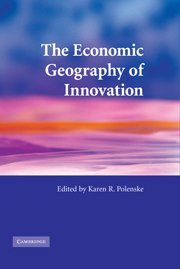Book contents
- Frontmatter
- Contents
- List of figures
- List of tables
- Notes on contributors
- Acknowledgments
- Abstracts
- List of abbreviations and acronyms
- Part I Concepts and measurements in innovation
- Part II Institutional and spatial aspects of information and knowledge flows
- 5 Tacit knowledge in production systems: how important is geography?
- 6 The self-aware firm: information needs, acquisition strategies, and utilization prospects
- 7 Theorizing the gendered institutional bases of innovative regional economies
- 8 Multinationals and transnational social space for learning: knowledge creation and transfer through global R&D networks
- 9 Brain circulation and regional innovation: the Silicon Valley–Hsinchu–Shanghai triangle
- Part III Institutions and innovation systems
- Index
- References
6 - The self-aware firm: information needs, acquisition strategies, and utilization prospects
Published online by Cambridge University Press: 22 September 2009
- Frontmatter
- Contents
- List of figures
- List of tables
- Notes on contributors
- Acknowledgments
- Abstracts
- List of abbreviations and acronyms
- Part I Concepts and measurements in innovation
- Part II Institutional and spatial aspects of information and knowledge flows
- 5 Tacit knowledge in production systems: how important is geography?
- 6 The self-aware firm: information needs, acquisition strategies, and utilization prospects
- 7 Theorizing the gendered institutional bases of innovative regional economies
- 8 Multinationals and transnational social space for learning: knowledge creation and transfer through global R&D networks
- 9 Brain circulation and regional innovation: the Silicon Valley–Hsinchu–Shanghai triangle
- Part III Institutions and innovation systems
- Index
- References
Summary
Introduction
Debate about the extent to which regions can foster innovation moves in two divergent directions. The first set of analysts takes a normative approach in suggesting what makes regions and firms competitive, innovative, and resilient. Their perspective draws largely on case studies of “successful” regions or firms where learning either occurs or is suboptimal (Lam 1997; Amin and Cohendet 1999; Capello 1999; Keeble and Wilkinson 1999; Lawson and Lorenz 1999; French 2000; Henry and Pinch 2000; Florida 2002; Lambooy, 2002; Storper 2002; and Gertler 2003a, 2003b). The second set of analysts' perspectives takes a positive approach to firm learning and investigates the practice of information acquisition, knowledge creation, and behavioral change in firms (Glasmeier 1991, 1999, 2001; Glasmeier et al. 1995; Feller, Glasmeier, and Marks 1996; Harrison and Glasmeier 1997; Glasmeier et al. 1998; Meeus, Oerlemans, and Boekema 2000; and Oerlemans, Meeus, and Boekema 2000). While the first set suggests that firms can and do act deliberately and with forethought, the second set suggests that firms are reactive, incremental, and myopic, and are motivated by factors that include life-style considerations rather than profit maximization.
The first type of investigation supports the belief that to be successful in the new economy, firms must have superior abilities to network, acquire new information, turn it into knowledge, learn from its internalization, and act upon it (Cooke 2002; Gertler and Wolfe 2002; Storper 2002).
- Type
- Chapter
- Information
- The Economic Geography of Innovation , pp. 112 - 128Publisher: Cambridge University PressPrint publication year: 2007



